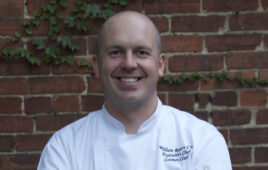For some clubs, small plates are great. But for others, they can pose big problems that require smart solutions.
Small plates have many advantages. They allow members to sample a wide variety of dishes; they’re casual and sharable; they can be pieced together to form a meal, or be enjoyed as a snack between or before regular dining occasions.

Organic salmon served on a cedar plank with a roasted Jersey peach and fig jam by Spring Lake (N.J.) Golf Club’s Executive Chef Martin Plastiak.
But while many clubs have found small plates to be a useful addition to their operations, especially in bars and on buffets, for others they can present big problems that demand clever solutions.
Spring Lake (N.J.) Golf Club is one such example.
“We tried a small-plates menu, but it didn’t work,” says Executive Chef Martin Plastiak, who came to the club three years ago after working in a variety of renowned kitchens in New York City, including La Bernardin.
Spring Lake’s small-plates menu created logistical challenges both in the back and front of the house, and the concept created obstacles for an otherwise seamless service operation. So Plastiak, who changes the club’s menu weekly, decided to kill the small-plates menu completely and instead offer tasting portions of full-size entrees. This solution bridged the gap for members who wanted access to downsized dishes, while also eliminating the operational problems associated with a dedicated menu.
“For entrees that are available in a tasting portion, we simply include a small “t” beside the description of the dish [on the club’s menus],” says Plastiak. “It’s simple and cost-effective.”
Recognizing that small plates have a place, Plastiak came up with a clever way to introduce and showcase them.
“I push my cooks to constantly create new dishes,” he says. “So when we’ve created something interesting and delicious, we send it out to a single table as a small plate, compliments of the chef,” he says.
This practice creates a tremendous amount of good will with members, he reports, while simultaneously inspiring cooks to come up with interesting and creative dishes.
“It’s functional menu development that also happens to increases member satisfaction,” says Plastiak.
The Real Diehl
On the other side of the country, a small-plates menu was a welcomed addition to a California club’s pool operation this past summer.
Ahi Tuna Poke-Diced Yellow Fin Tuna with Diced Tomato, Avocado, Cilantro and Japanese Yuzu Dressing Wasabi Crème Fraiche, Toro Chips by Diablo CC’s Executive Chef, Scott Diehl
“Giving members a chance to sample a variety of dishes at a lower price point was my way of introducing myself as their new chef,” says Scott Diehl, who became Executive Chef of Diablo (Calif.) Country Club in June. “We created some really great plates that had big, bold flavors and colors. They popped, and the members loved them.”
Some of the more popular small plates at Diablo include a local Dungeness crab cake served atop a spicy Dijon mango coulis and a tropical fruit salsa; a pan-roasted Maine diver sea scallops served with fresh heart of palm, wild mushrooms and a bittersweet blood orange sauce; and an Ahi tuna poke made with diced yellowfin tuna, tomato, avocado, and cilantro, topped with a Japanese yuzu dressing, wasabi crème fraiche and sided by toro chips.
“We were able to purchase new slate plates for the small plates, so the food stood out on them,” says Diehl.
The challenge was coming up with dishes that cross-utilized ingredients, because space is a challenge at Diablo CC, which has 790 members and does about $3.5 million in annual F&B. But that didn’t stop Diehl. “A challenge is simply an opportunity to work harder and be more creative,” he says.
Bites for Buffets
Small plates also shine on buffets at Braemar Country Club (Tarzana, Calif.), which has 2,100 members and does roughly $6 million in annual F&B. Executive Chef Robert Lia uses them to showcase the skill and talent of his culinary team while also exposing members to lots of unique little tastes.
“Each dish is interesting on its own—but creating a tapas menu that’s cohesive is what gets our members excited,” says Lia, who has been with Braemar CC for a little more than a year and a half. “It also helps us to move through inventory.”
As a certified sommelier, Lia especially enjoys pairing his various tapas menus with wine.
“A lot of people get bored with full-sized entrees during wine pairings,” says Lia. “Tapas eliminate plate fatigue. Plus, when you create four or five totally different dishes to pair with one glass of wine, your palate gets to experience more characteristics in the wine than it would with only one food pairing.”
For a particularly successful Spanish wine pairing earlier this year, Lia stuffed piquillo peppers with goat cheese, sliced them, and layered them with peewee fingerling potatoes. He topped the salad with octopus that was bagged with chimichurri and cooked sous vide.
“Small plates let you take greater risks as a chef and they’re less intimidating for members,” says Lia. “Any time we do a member event with tapas, the response is phenomenal. In some situations, it’s simply a better way of serving food.”


